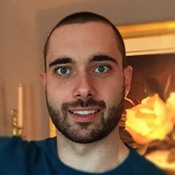Program Information
Using Virtual Reality to Facilitate the Creation of Patient-Specific Bolus
J Sutherland*, A Sheikh , F Rybicki , J Belec , The Ottawa Hospital, Ottawa, ON
Presentations
SU-H4-GePD-J(A)-6 (Sunday, July 30, 2017) 4:30 PM - 5:00 PM Room: Joint Imaging-Therapy ePoster Lounge - A
Purpose: This work describes a clinical process for creating treatment planning system (TPS) designed patient-specific bolus by using virtual reality (VR) visualization to enable tracing bolus outlines on patient skin.
Methods: Bolus is designed on patient external contours with the Monaco 5.11 TPS. The bolus is exported as a DICOM structure and then converted to a mesh using the PyDICOM python library to convert the structure to a voxelized mask and the Visualization Toolkit (VTK) to convert the mask to a mesh.The patient’s virtual external contour and bolus are visualized using the HTC Vive VR system and an in-house program created in the Unity game engine. The patient is immobilized in their CT-simulation position and the virtual meshes are aligned with the patient’s real-world position by recording the precise 3D locations of the patient’s CT-simulation tattoos. The bolus outline is then traced on the patient’s skin with a tracked marker while visualizing the desired bolus mesh and tracked marker position in VR. Tattoo locating and marker tracking are managed by attaching custom 3D printed (Connex3, StrataSys™) housings to the tracked Vive controllers.With the outline drawn, custom bolus can be conventionally produced using wax or super-flab. The final product is verified by creating a 3D scan of the patient with the Occipital Structure Sensor and an iPhone and quantifying the difference between the scanned bolus and its associated virtual planning mesh. Final quality control is performed with day-one on-board treatment imaging.
Results: Bolus outlines are drawn with an accuracy of 1 mm and custom bolus can be created within approximately 15 minutes.
Conclusion: Despite being a technologically complex solution to a mundane problem, we found this process to be a smooth method of producing precise, complex patient-specific bolus without the costly use of linac light-fields or time-consuming 3D printing.
Contact Email:
